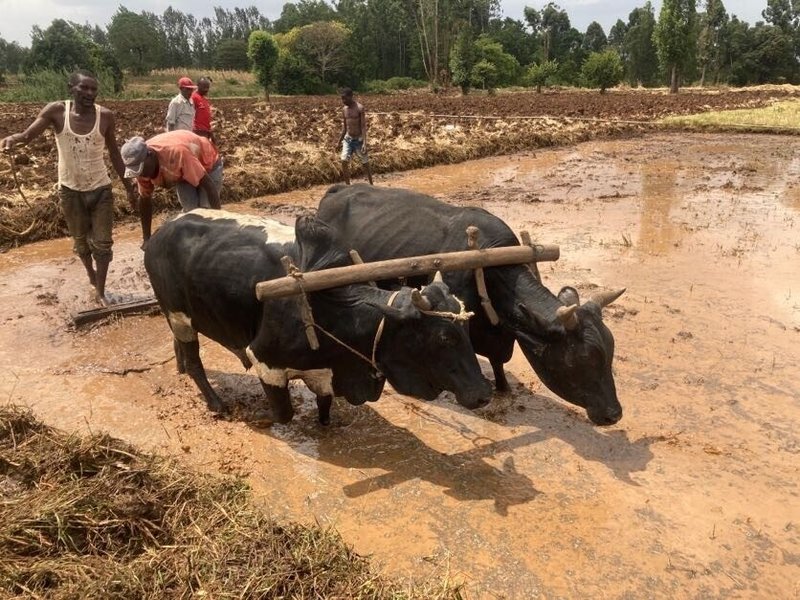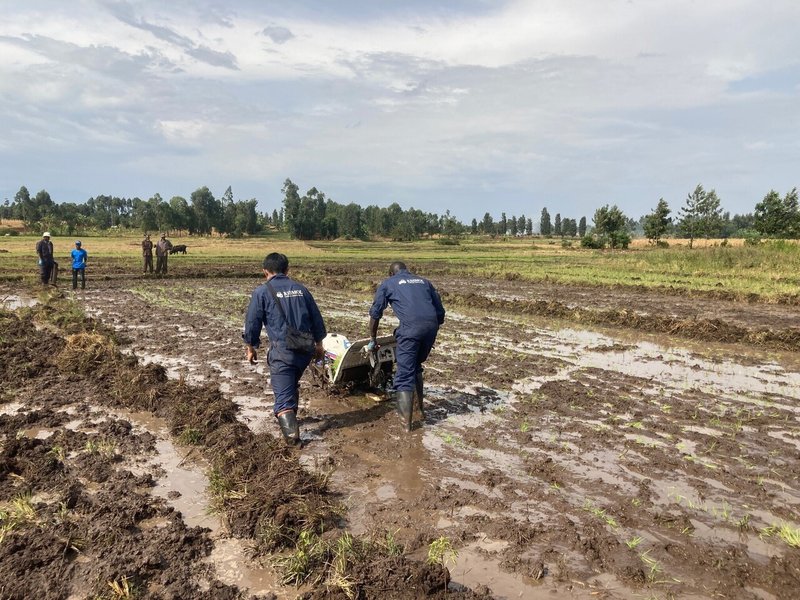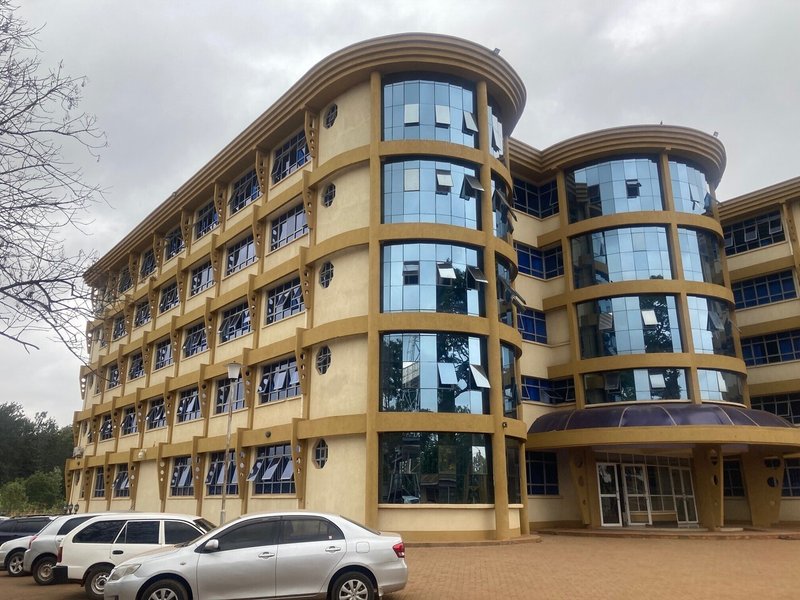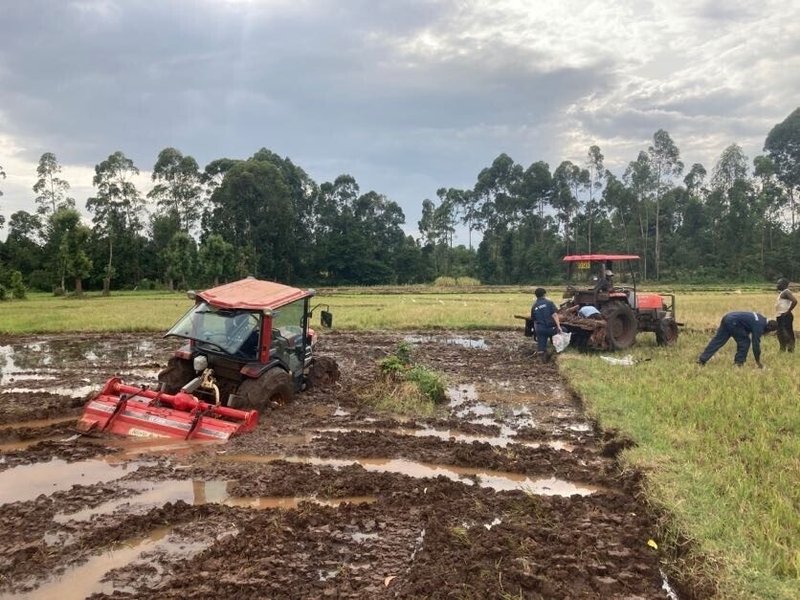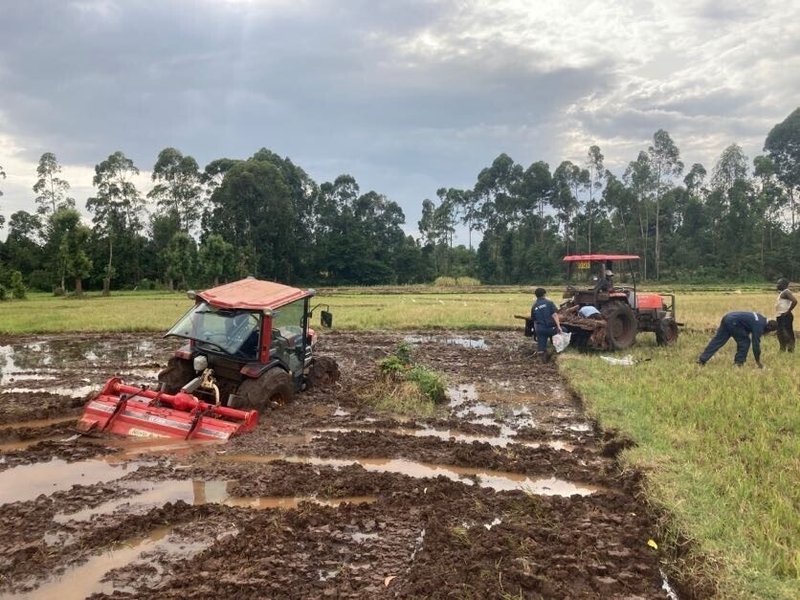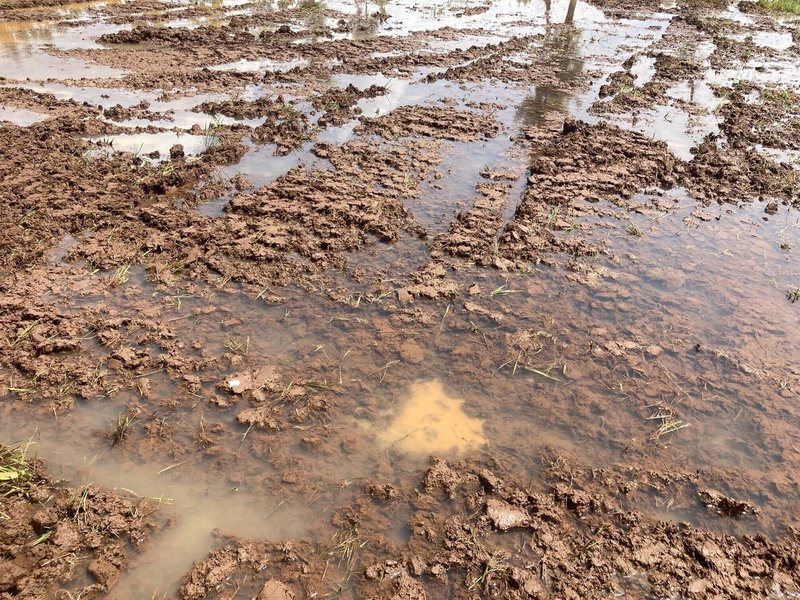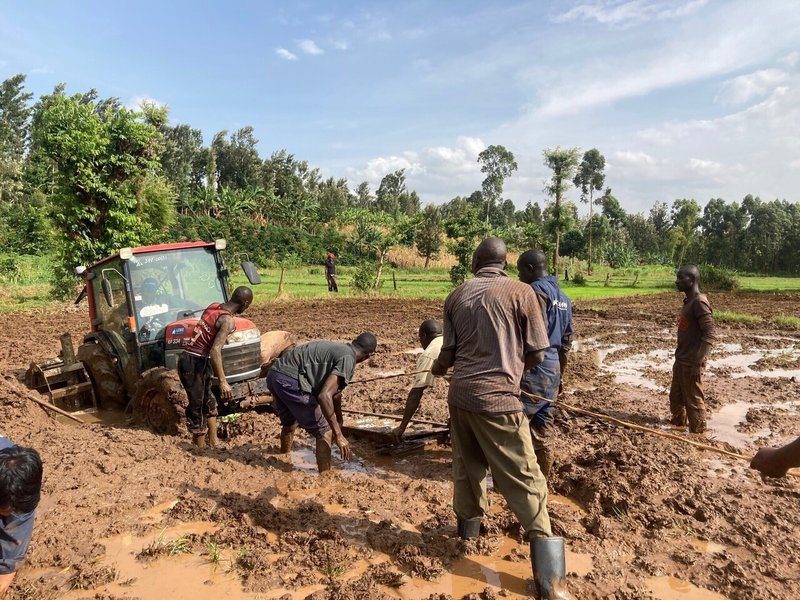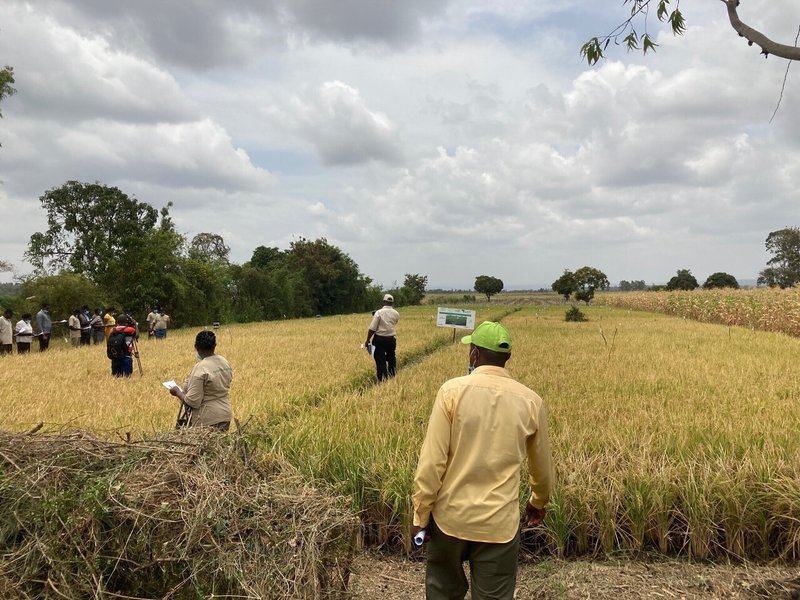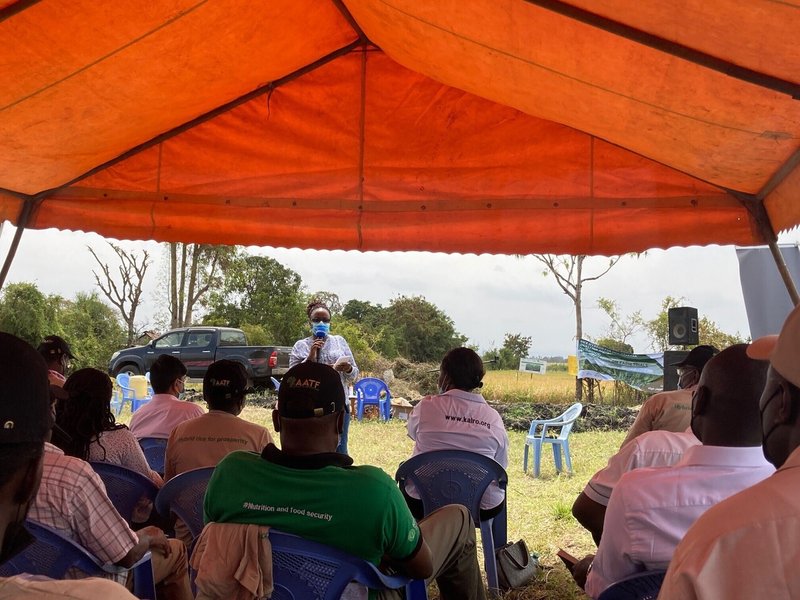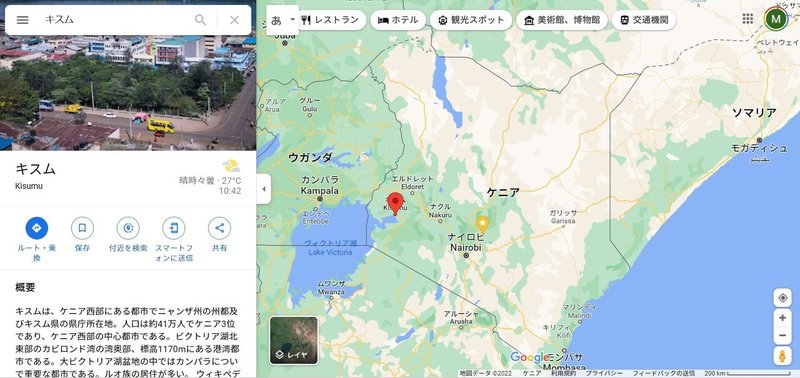I am Mikio Oyama, the CEO of KiliMOL.
I was in Mwea last week too. It sometimes rained a little in the morning and evening, and the temperature was in the low 20 s, which was a little chilly, but in the daytime the temperature went up to over 30 degrees, and under the direct sunlight I sweat. The real rainy season starts around here in March.
1. Demonstration of walking type rice transplanter
On Monday, a demonstration of a walking type rice transplanter was held for ICOSEED. The Embassy of Japan in Kenya and JICA visited Mwea to see the Thiba Dam being constructed under the Mwea Irrigation Scheme, and its guide Mr. Yunoki from Nippon Koei and Mr. Fukui from KAI Global who purchases Japanese rice from contracted farmers at Mwea also came to our demonstration. On the weekend, ICOSEED was supposed to flatten the field to make it easier to plant rice seedlings, but that wasn't the case. Before the demonstration, ICOSEED hurriedly used nearby cows to flatten the field and manually scraped out the remaining straw. When I saw how cows were whipped and worked, I realized again that this is Kenya, and together with donkeys who transport animals on the road, livestock are still active here.
In the end, the field was not completely flat and there was too much water, so we decided to use another field instead. The place we moved to wasn't even flat, so planting with the rice transplanter didn't work perfectly, but we were able to show what a walking type rice transplanter looks like. In a few years at the latest, the machine will replace the manual planting. By the way, in Japan, walking type rice transplanters began to spread rapidly from around 1970, and later riding rice transplanters also spread.
ICOSEED also approached officials from the County Government of Kirinyaga, who introduced us to their senior positions, and on Thursday we were able to visit their offices for discussion.
2. Tractor got stuck in the rice field
Continuing from last week, on Tuesdays, we farm with 34 horsepower tractors. But the big catch is literally ・・・. I wasn't there, but the tractor that was running the rotary suddenly sank and fell into the trap. When I came to see it, the rear wheel was already half full.
It would be very difficult to escape. If we had attached a big wheel to the outside of the rear wheel of the tractor, we might have been able to manage it, but the field around here is not deep, so we thought I wouldn't get addicted to it. Moreover, each section is small, so we removed the big wheel in order to make it easier to turn around. we don't think we can pull it out by ourselves. And because of the remote location of the field, it's not easy to find another tractor to pull our tractor for rescue.
We managed to get a Kubota 45 hp tractor to come in the evening and pull our tractor with a chain, trying all sorts of things to pull it out of the mire, but it was not successful… . As it got darker and darker, the tractor had to go home, so we decided to suspend. We opened the water discharge exit at the edge of the field so that we could remove the mud around the tractor by reducing the amount of water.
When we came to the field the next day, Wednesday, the water didn't drain as much as we thought. We looked at the field carefully, and found out that for some reason there is a spring water in this area, and the surrounding area has become soft. This left behind water and even revealed soft parts of the soil.
In order to evacuate the tractor by the end of the day, we managed to contact the operators of the large Western Maker’s tractor (75 horsepower) and asked them to contact us as soon as his work was finished. We worked on removing mud and water around the tractor. However, we couldn't get in touch with the workers of the large tractor. One of our Kenyan staff, who was in contact with the worker of the large tractors, said from the beginning, "I doubt if they will really come," so I guess this is kind of “No first time customers”.
When the soil and water around the rear tires finally disappeared after the work to remove water and mud, we tried to escape again with a big wheel, but failed.
Later, in the application of the method of sticking a stick into a big wheel and into the ground, which was taught by the CEO of Karasawa Agricultural Machinery Service, Mr. Karasawa, the stick into the big wheel was stuck between the aluminum ladder so that the aluminum ladder could be put under the big wheel. At the same time, we had people around us pull it like a tug of war. The result was .... Check out the video below for an immersive experience.
We finally managed to escape! The children around us were very happy! I'm so relieved to be able to escape!
That said, we've lost almost two full days, and we're reminded of the risks of rotavator service provider.
3. FIELD DAY Event
On Friday, we participated in an event called LOWER MWEA FIELD DAY organized by ICOSEED and AATF (African Agricultural Technology Foundation). Farmers are participating in the event, which is the unveiling of four new varieties of rice. It yields up to 7 tons/acre (≒ 17.5 tons/ha). The average yield in Kenya is said to be 5 tons/ha, so this new varieties are incredible.
Here I first got to see how the agricultural events in Kenya are going.
It was supposed to start at 9:00 AM with a field trip and hold speech from 10:00, but the actual speech started at 1:00 PM, which was three hours late! It's unbelievable in Japan, but nobody seems to care about this delay. The culture of “Pole Pole” (Swahili meaning for "slow and slow") is fully established, hahaha. Various related organizations and companies come forward in order, and each one makes a speech in order such as thanking the host, introducing the company, and so on. This goes on and on. I was the kind of person who was tired of listening to schoolmaster’s long speech at an elementary school morning assembly, so I was just amazed by the number of people who talked and the long stories of each person. I’m sure that Kenyans love to talk. Toward the end, at around 14: 45, KiliMOL was also given time to explain, and we tried to make our case. After that, some people continued to talk, and we took a group photo, and finally lunch was served around 15: 40.
What impressed me during the speech was that although the consumption of rice in Kenya iss growing rapidly and the domestic production is increasing, it was far short of the consumption and 89% of the consumption is imported from Pakistan and India. They are passionate about changing this situation at any cost by increasing their own production from the perspective of food security and preventing the outflow of foreign currency. KiliMOL will also contribute to the mechanization of agriculture.
We encountered various troubles this week as well, and I keenly felt the difficulty of the agriculture and agricultural machinery business. However, I felt the development of the region, such as the increase of tractors clearly compared to last time when I came to Mwea six months ago, the pavement construction of the main road from Nairobi has progressed significantly, and the roads in the Mwea region, which had been rough up to now, have been paved cleanly. I think this country will continue to grow.
(Source: Google Map)
Next week, I will go on a business trip to Kisumu, Kenya's third largest city in western Kenya. It's my first time to visit Kisumu, so I'm looking forward to it!


